8 Types Of Glass For Aquariums [2025]

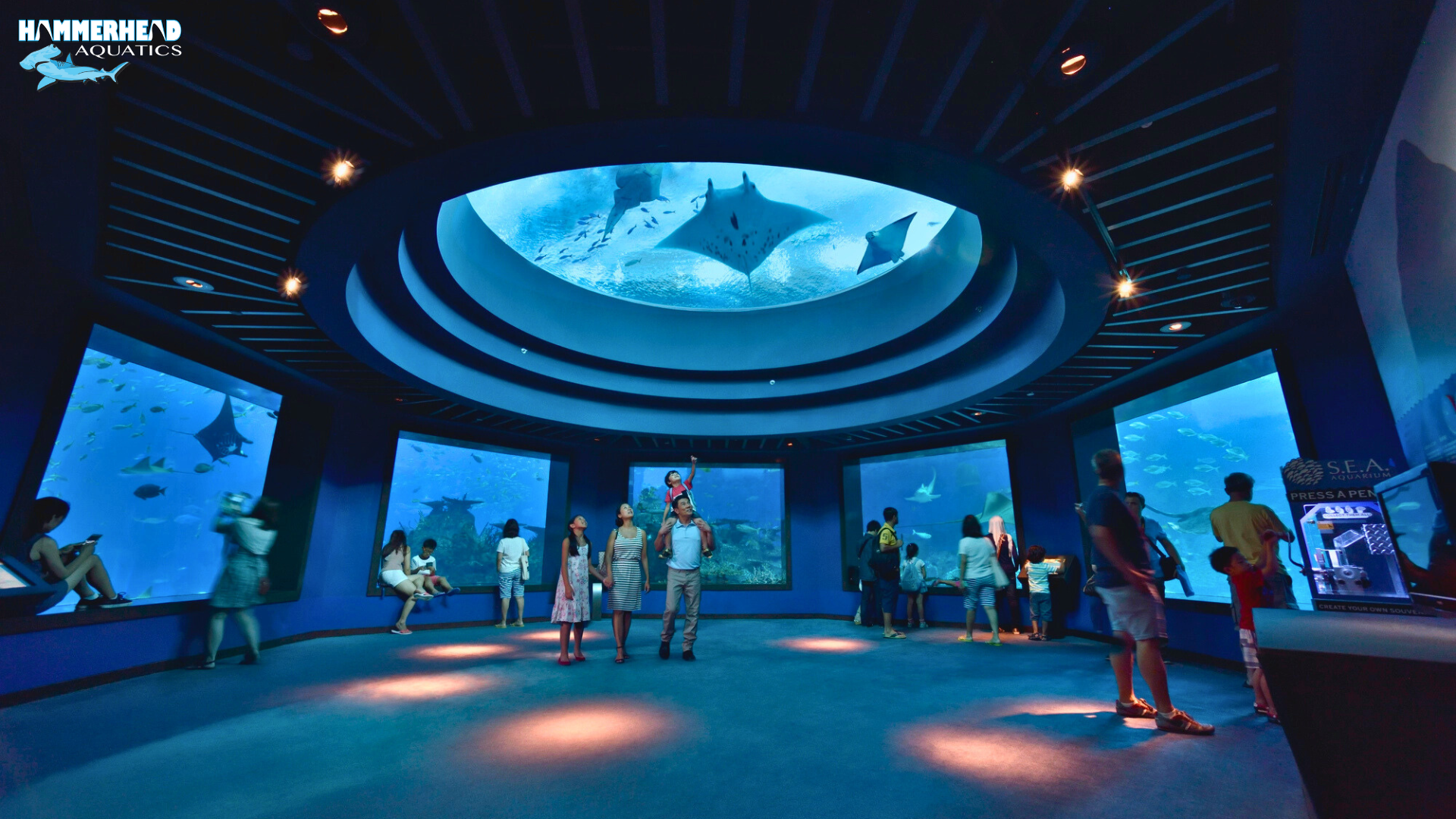
When I started designing aquarium windows and large viewing panels two decades ago, the most common question from clients was: “Which glass is safest, clearest, and most reliable over the 30+ years this tank should last?” Over time, I've tested, installed, and retrofitted dozens of high-stakes aquariums, from home reef tanks to public aquarium exhibits. So I’ve seen firsthand how different glass types behave, age, and even fail under pressure, temperature cycles, or impact.
In 2025, the choices for aquarium glass have broadened. Advances in material science, coatings, and safety engineering mean it’s no longer automatic that you just pick “glass, 10 mm, done.” You must match clarity, structural strength, cost, and long-term durability to your tank’s geometry, light path, and use case.
This article will serve as both your go-to reference and checklist. We’ll walk through 8 types of glass for aquariums, dividing them into “primary / common” and “less common / specialized” options. For each, you’ll learn what they are, advantages and disadvantages, and a rough idea about the cost.
If you read to the end, you’ll end up confident in choosing the right glass for your next aquarium or retrofit, avoiding expensive regrets.
Let’s begin.
TL;DR — Key Takeaways
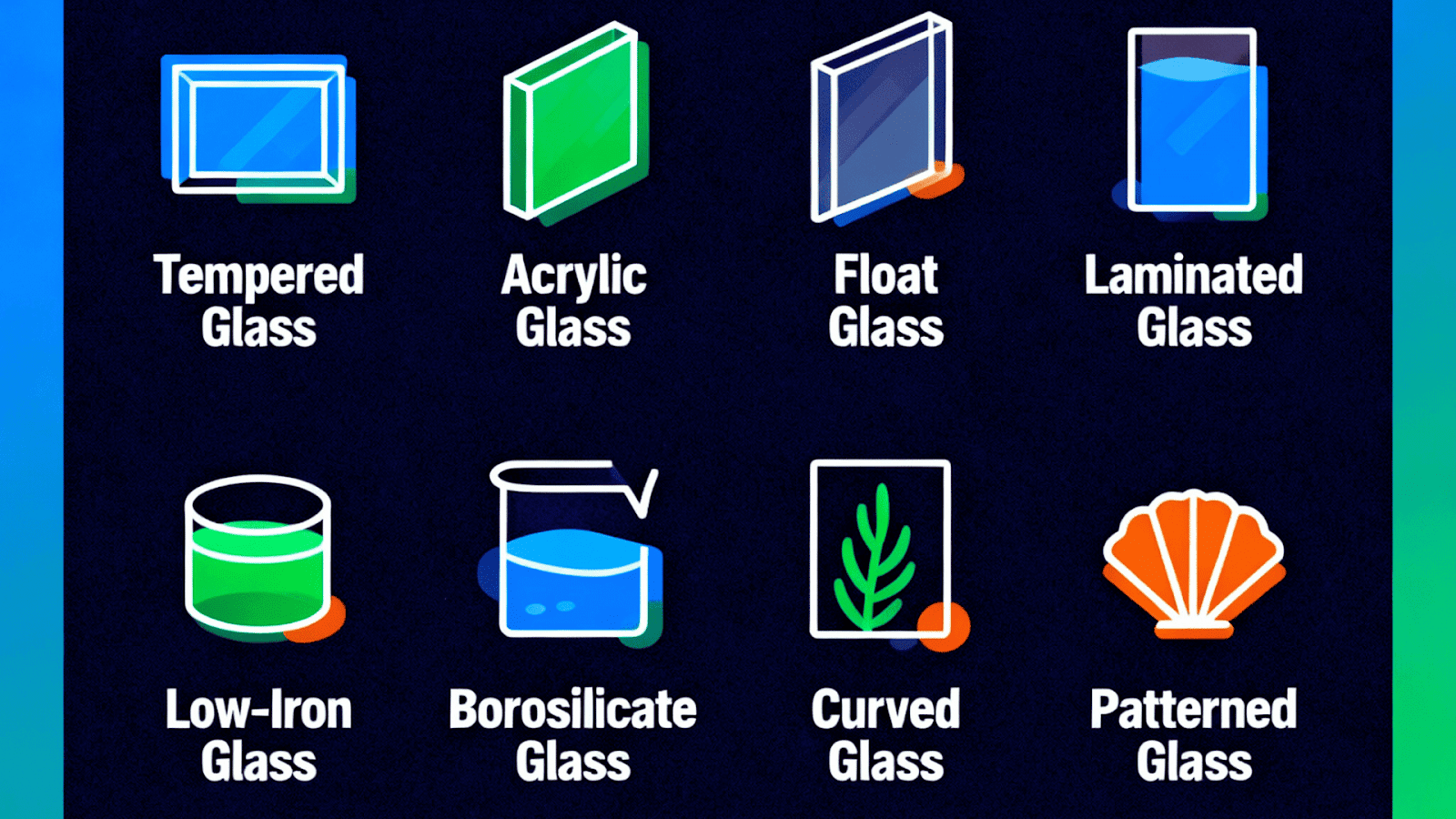
- Annealed (float) glass is the baseline for many tanks because it's versatile and modifiable, but it’s less strong and less safe in large spans.
- Approximate cost of annealed glass: ~$200 for 48x24x0.5 in panel.
- Approximate cost of annealed glass: ~$200 for 48x24x0.5 in panel.
- Tempered glass is ~4x stronger than annealed and breaks into safer granules; ideal for high-stress panels, though you can’t drill it afterward.
- Approximate cost of tempered glass: ~$300 for 48x24x0.5 in panel.
- Approximate cost of tempered glass: ~$300 for 48x24x0.5 in panel.
- Laminated glass offers safety — even when cracked, fragments stay bonded, making it ideal for large tanks or public displays.
- Approximate cost of laminated glass: ~$350–$400 for 48x24x0.5 in panel.
- Approximate cost of laminated glass: ~$350–$400 for 48x24x0.5 in panel.
- Low-iron (OptiClear / Starphire) glass gives superior clarity and removes the green tint, which is very noticeable in thick panels.
- Approximate cost of low-iron glass: ~$450 for 48x24x0.5 in panel.
- Approximate cost of low-iron glass: ~$450 for 48x24x0.5 in panel.
- Heat-strengthened glass sits between annealed and tempered in strength and break behavior—useful in bridging compromise zones.
- Approximate cost of heat-strengthened glass: ~$270 for 48x24x0.5 in panel.
- Approximate cost of heat-strengthened glass: ~$270 for 48x24x0.5 in panel.
- Wired glass and patterned / textured glass are rarely used in aquariums but may serve in decorative or niche structural roles.
- Approximate cost of wired glass: ~$320 for 48x24x0.5 in panel.
- Approximate cost of patterned/textured glass: ~$250 for 48x24x0.5 in panel.
- Bullet-resistant / multi-layer security glass is overkill for most home tanks but occasionally used in public, high-risk installations.
- Approximate cost of bullet-resistant glass: ~$1,500+ for 48x24x1.25 in panel.
- Approximate cost of bullet-resistant glass: ~$1,500+ for 48x24x1.25 in panel.
- Glass cost depends heavily on size, thickness, clarity, edge finishing, transport logistics, and fabrication complexity (cutting, polishing, lamination).
If you want to build an aquarium, always consult a specialist with a proven track record (such as Hammehead Pools). Aquariums are costly and not something to take lightly.
Now let’s get into the details.
Primary / Common Types of Glass for Aquariums
Normally you will only hear about four types of glass for aquariums. Many don’t know there are more. And no, I’m not talking about alternatives.
So first we will look at these 4 common types of aquarium glass. And then we will learn about four more that are rather uncommon.
1. Annealed (Float) Glass
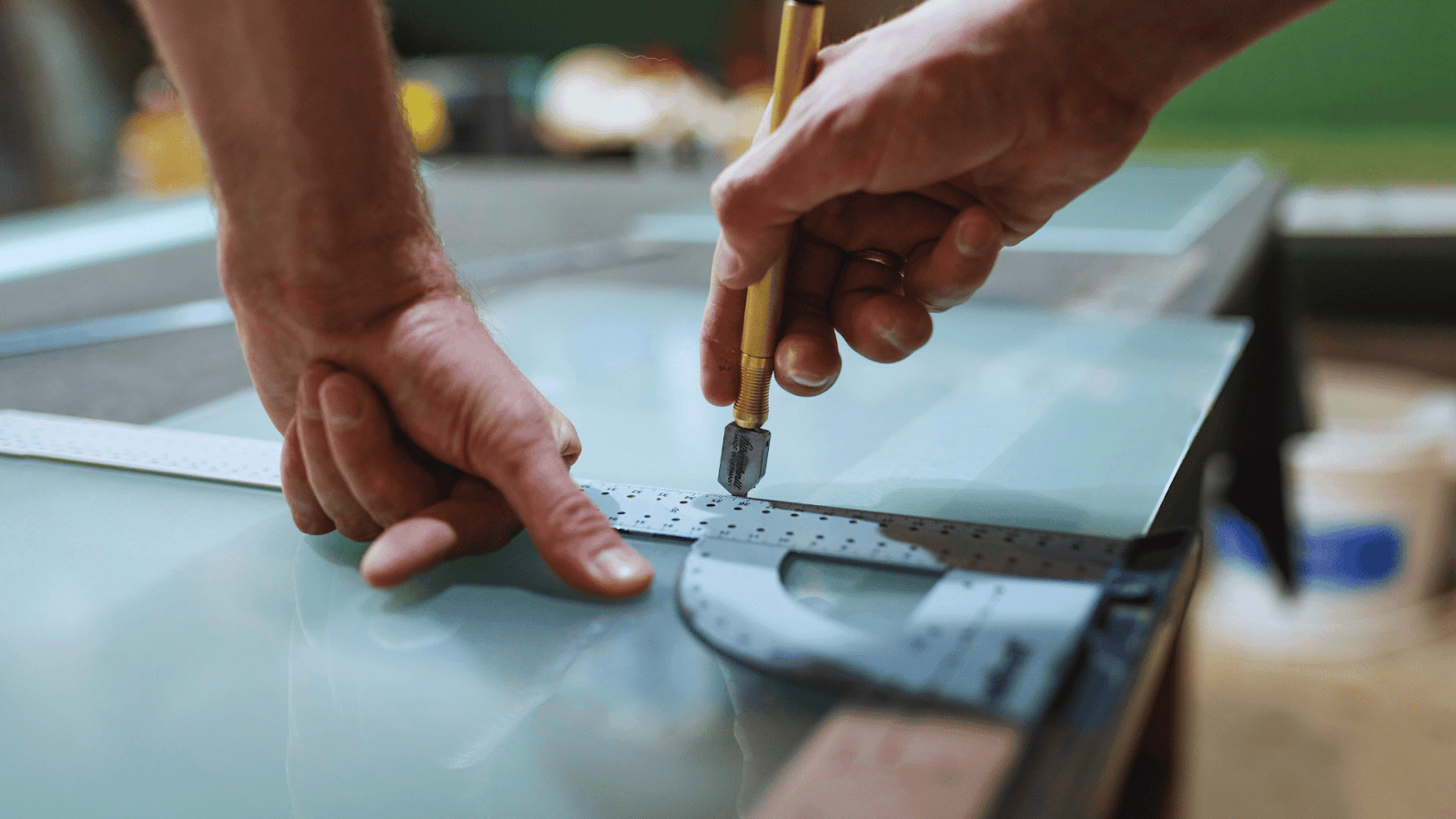
Annealed glass (often called “float glass” or “regular glass”) is produced by cooling molten glass slowly to relieve internal stresses. It is the baseline, “do-it-all” glass used in windows, glasscraft, and many aquarium walls. Because it’s not pre-stressed, you can cut, drill, or polish it in workshop settings or even in the field (within limits).
Advantages Of Using Annealed Glass For Aquariums
- Highly versatile: you can cut, drill, or polish after production.
- Lower cost relative to tempered, laminated, or other specialty glasses.
- Predictable failure behavior: when stressed, it fractures into sharp shards rather than totally shattering. Some cracks may be repairable (in limited cases).
- Good for smaller or lower-stress aquariums where large spans or high water pressure aren’t dominating factors.
Disadvantages Of Annealed Glass
- Lower strength: comparatively weak in bending or impact scenarios.
- Safety risk: in failure, you get large sharp shards that can injure or cause catastrophic leaks.
- Long spans or tall tanks may require thicker glass or excessive reinforcement.
- Edge defects or micro-cracks propagate more easily because there isn’t residual compressive stress to “stop cracks.”
When to Use Annealed Glass
- Smaller tanks (e.g. < 18 inches height) or fishrooms where spans are moderate.
- Tanks where modifications (drilling, ports, bulkheads) are anticipated.
- Budget-conscious or backup tanks.
Cost Considerations
Since annealed glass is common, its unit cost is comparatively low. In many markets, you may pay 20–40% less compared to tempered or extra-clear glass. For example, a 1 m × 1 m panel at 12 mm thickness typically costs around $200–$220 USD (including cutting and edge finishing).
2. Tempered Glass
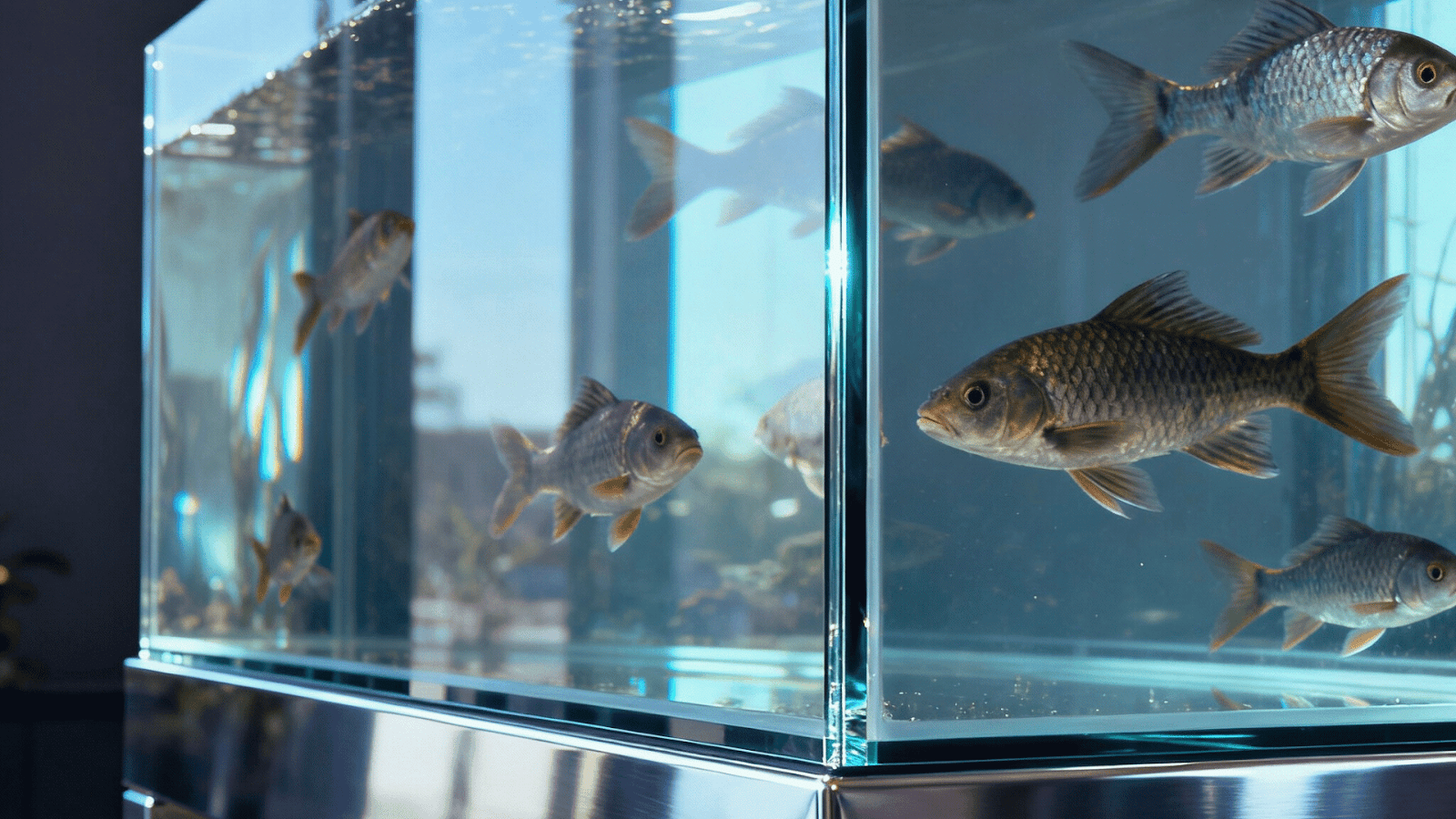
Tempered glass is annealed glass that undergoes a controlled heating-and-cooling process, inducing compressive stresses on the surfaces and tensile stress inside. This significantly increases strength and changes failure behavior: when it breaks, it shatters into many small pebble-like fragments rather than jagged shards.
A classic high-stress application: bottom or side panes of a large aquarium where you want extra margin in bending strength.
Advantages Of Using Tempered Glass For Aquariums
- ~4x the strength (in bending / flexural) compared to annealed of the same thickness.
- Safer breakage mode: fragments are smaller, less sharp, reducing deep penetration injuries.
- Good for high-stress panels or large spans where bending would otherwise be an issue.
- Reduced bowing in large panes due to the added strength.
Disadvantages Of Tempered Glass
- Cannot be cut, drilled, or polished post-tempering. You must finalize all shaping before tempering.
- If even a small scratch or edge flaw occurs, it can lead to spontaneous shattering.
- When it fails, it typically fails all at once (catastrophically) rather than gradually leaking.
- Edge stresses are critical; damage near edges is more dangerous than in annealed.
- Higher cost due to the tempering process and the need for precision.
When To Use Tempered Glass
- Panels under high bending stress (e.g. long spans, rimless tanks)
Bottom panels (especially on big tanks) - When you want a safety margin but aren’t willing to go full laminated
Cost Considerations
Tempered glass typically commands a 30–80% premium over comparable annealed float glass. For instance, a 1 m × 1 m panel at 12 mm thickness usually costs $300–$330 USD, depending on supplier and finish.
3. Laminated Glass (Safety / Composite Glass)

Laminated glass is made by bonding two or more glass sheets using one or more interlayers (commonly polyvinyl butyral, PVB, or ionoplast layers). Even if one layer fractures, the interlayer holds pieces together. In aquarium applications, you see laminated panels used in large viewing windows, public aquariums, or flood-control / safety-critical installations.
Advantages Of Using Laminated Glass For Aquariums
- Safety: fracture does not lead to panel collapse; the shards remain adhered.
- Good for large, tall tanks or where public safety (e.g. in malls, zoos) is required.
- You can combine different glass types (e.g. annealed + tempered) for tailored strength.
- Even under severe impact, leak paths are slower (giving you time to act).
- It can handle post-failure without total collapse.
Disadvantages Of Laminated Glass
- Cost is high due to the interlayer and lamination process.
- Optical distortions (especially in first-generation laminates); the interlayer may cause slight haze or ghost reflections.
- Thickness can balloon: you’re paying for two panels plus interlayer.
- More difficult logistics; heavy, complex handling.
- The bonding process must be flawless; bubbles or delamination can be fatal in underwater use.
When To Use Laminated Glass
- Large display tanks (e.g. museum / public aquaria).
- Installation in earthquake zones or areas with impact risk.
- Tanks with visitors on both sides or where safety is paramount.
- Retrofitting older tanks that might benefit from secondary containment.
Cost Considerations
Laminated glass generally costs 2× or more compared to single-pane glass. For aquarium-grade laminated panels (e.g., 6 mm + 6 mm with PVB), a 1 m × 1 m panel will usually be $350–$400 USD. Larger or low-iron laminated sheets can exceed $500 USD.
4. Low-Iron Glass (OptiClear / Starphire / UltraClear)

Low-iron or ultra-clear glass is manufactured with very low iron content (often ≤ 0.01 %), compared to standard float glass which has more iron and thus a greenish tint. The reduced iron gives superior optical clarity and better color fidelity, especially noticeable on thick panels or in tanks where you’re seeing across multiple feet of glass.
If you’re building a rimless show tank or a reef tank where color pop is critical, low-iron is often the go-to.
Advantages Of Using Low-Iron Glass For Aquariums
- Much clearer, cleaner visuals; less green tint, better color fidelity, more “invisible” look.
- Better edge clarity (important in rimless styling).
- Allows higher perceived contrast for corals, plants, and fish.
- Doesn’t necessarily weaken structural integrity if properly manufactured.
Disadvantages of Low-Iron Glass
- More expensive: the raw materials and manufacturing are costlier.
- Slightly softer or more prone to microscopic defects compared to standard float glass (some practitioners report more scratches).
- Handling and polishing must be done with extra care to avoid polishing lines or micro-cracks.
- In very thick installations, the clarity gain becomes less dramatic beyond a point (diminishing returns).
When to Use Low-Iron Glass
- Display tanks, rimless tanks, or tanks where clarity is a priority.
- Tanks you intend to photograph, film, or exhibit.
- Situations where optical performance outweighs cost.
Cost Considerations
Low-iron glass commands a 20–100% premium over standard float glass. A 1 m × 1 m, 12 mm thick low-iron panel typically costs $450–$480 USD. If tempered or laminated, expect $500–600 USD.
Uncommon / Specialized Types of Glass for Aquariums
These four types are niche, but in certain scenarios they may be exactly what you need.
5. Heat-Strengthened Glass
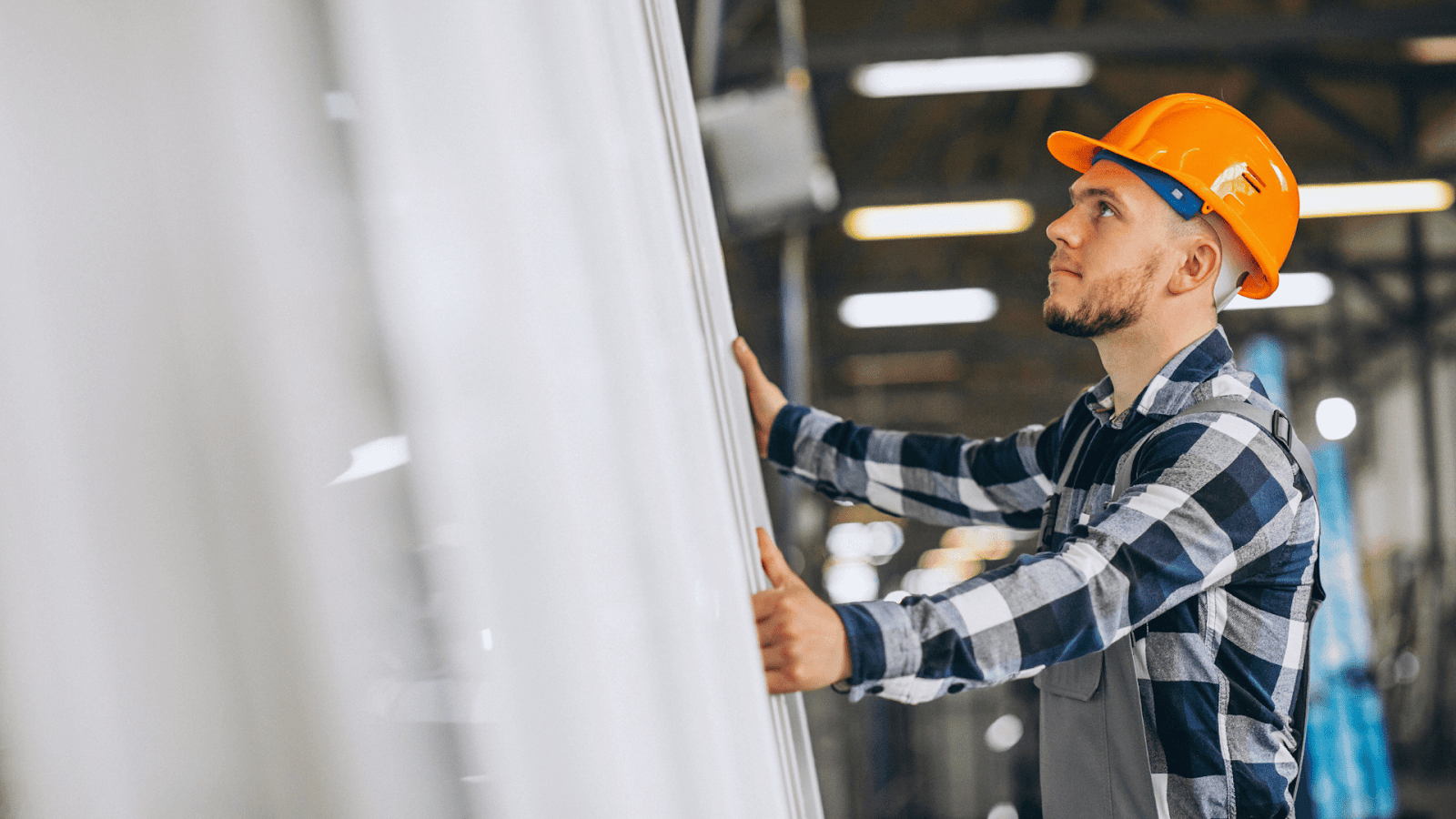
Heat-strengthened (or heat-strengthened annealed) glass is a midway option: it undergoes a heating process that induces some surface compressive stress, but not to the extent of full tempering. In breakage, it behaves more like annealed glass (splintering), but it offers better strength than plain annealed glass. According to architectural glass references, it's often ~2× strength of float glass (versus 4× for tempered).
One use of such glass is inside panels where you want a bit more safety margin but still want the possibility of modifying edges post-fabrication.
Advantages Of Using Heat-Strengthened Glass For Aquariums
- More strength than annealed (good for moderate spans).
- Less catastrophic failure risk than fully annealed in some cases.
- More forgiving than tempered in case of small flaws.
- Somewhat modifiable (less brittle than tempered).
Disadvantages of Heat-Strengthened Glass
- When it breaks, it still forms shards (though smaller than annealed shards).
- You lose some of the benefits of full tempering, so it's an intermediate compromise.
- Availability is more limited in the glass-for-aquariums market, so lead times and cost can be higher.
- Less tested in aquarium settings historically (less field data) compared to tempered or laminated.
When To Use Heat-Strengthened Glass
- Medium tanks where full tempering is overkill but annealed is too weak.
- Panels where post-fabrication modifications might be needed.
- Projects where cost must be controlled but you still want some strength cushion.
Cost Considerations
The price premium over annealed is moderate. A 1 m × 1 m, 12 mm thick panel usually costs $270–$290 USD. Limited availability may push this higher in some regions.
6. Wired Glass
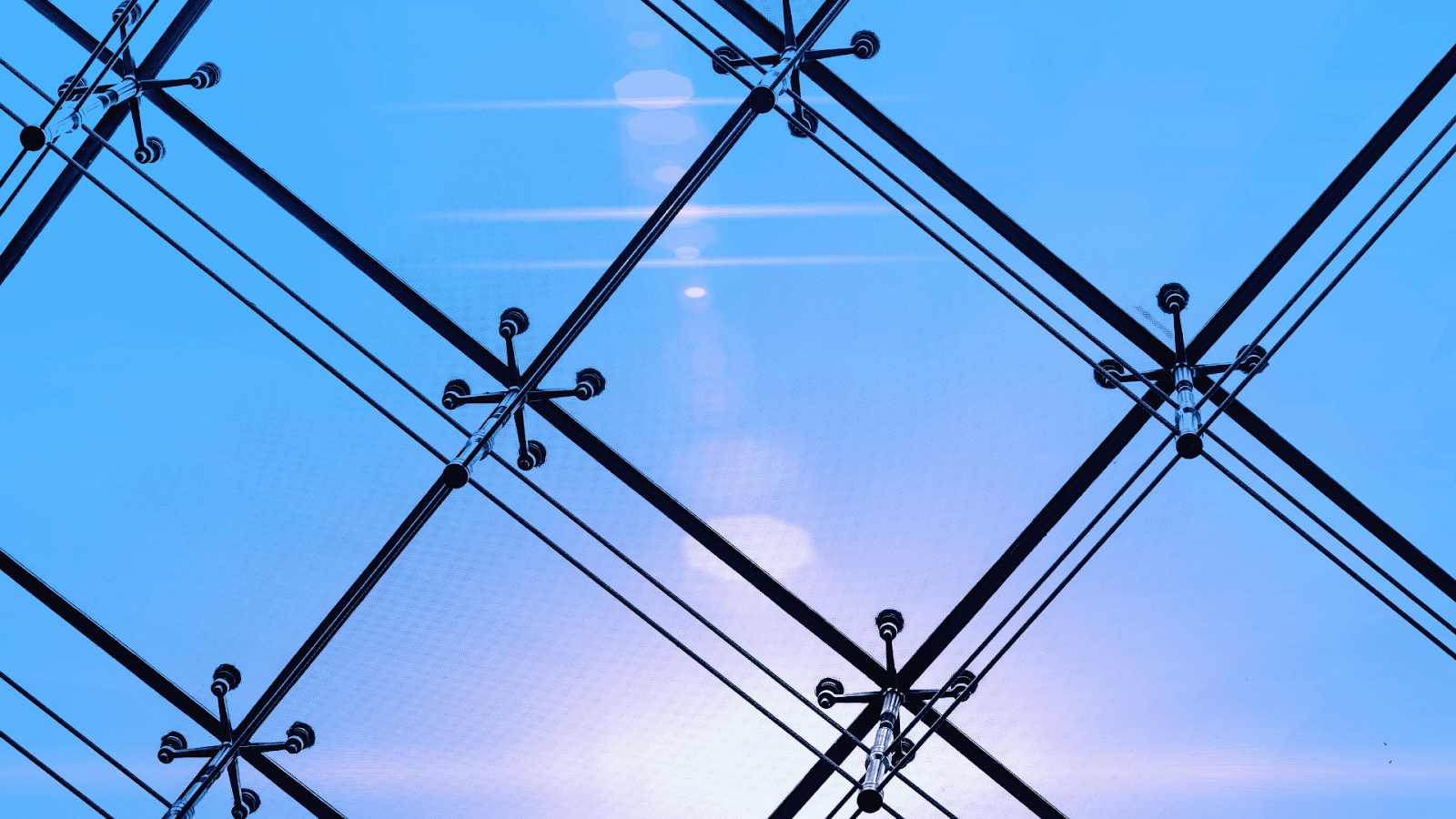
Wired glass embeds a wire mesh (usually steel) within the glass. Historically used for fire-rated windows or security glazing, wired glass is almost never used for aquarium panels because the wire mesh distorts visibility and can corrode. But in some architectural or decorative aquariums (e.g. a wall that doubles as a partition), wired glass may appear.
Advantages Of Using Wired Glass For Aquariums
- Fire-safety benefit (wire helps hold shards under fire or heat).
- Some security or decorative aesthetic value.
- Less shatter in extreme heat or fire situations.
Disadvantages Of Wired Glass
- Greatly reduces optical clarity (wire mesh visible, distortions).
- Prone to corrosion (especially underwater environment).
- Poor long-term durability in moist environments.
- Not structurally optimized for bending — the embedded wire often acts as a weakness plane.
When To Use Wired Glass
- In very specialized architectural aquariums where fire-code or partition function is required more than clarity.
- Decorative boundary walls (less depth, less pressure).
- Rarely. Most aquarium professionals avoid wired panels unless demanded by architecture.
Cost Considerations
Since wired glass is niche, the price can be high relative to its aquarium utility. A 1 m × 1 m, 10–12 mm wired glass panel is typically $320–$340 USD, depending on mesh type and finishing.
7. Patterned / Textured Glass

Patterned or textured glass includes glass with embossed or etched surfaces (frosted patterns, prismatic texture, ribbing, etc.). It’s typically used for decorative glazing (e.g. privacy panels) rather than for main aquarium viewing panels.
One of its potential uses is on the side or back panels in aquariums where you don’t need perfect clarity—e.g. in a wall display where one side faces a hallway.
Advantages Of Using Patterned / Textured Glass For Aquariums
- Decorative interest—can diffuse light or hide equipment behind.
- Can reduce glare or reflections in some lighting setups.
- Useful for partitions or background walls, not the primary viewing area.
Disadvantages Of Patterned / Textured Glass
- Reduced visibility and clarity—textures distort, blur, reflect.
- More expensive to manufacture with embossing or etching.
- Harder to clean (crevices accumulate biofilm).
- Not suitable for front-facing panels where clarity is demanded.
When To Use Patterned / Textured Glass
- As backing panels or decorative partitions in aquarium walls.
- In artistic installations, retail displays, or semi-transparent dividers.
- Where you intentionally want light diffusion rather than perfect clarity.
Cost Considerations
Patterning adds extra manufacturing steps. For aquarium-relevant thicknesses (~10–12 mm), a 1 m × 1 m panel generally costs $250–$270 USD. Custom patterns or imports can raise costs further.
8. Bullet-Resistant / Multi-Layer Security Glass
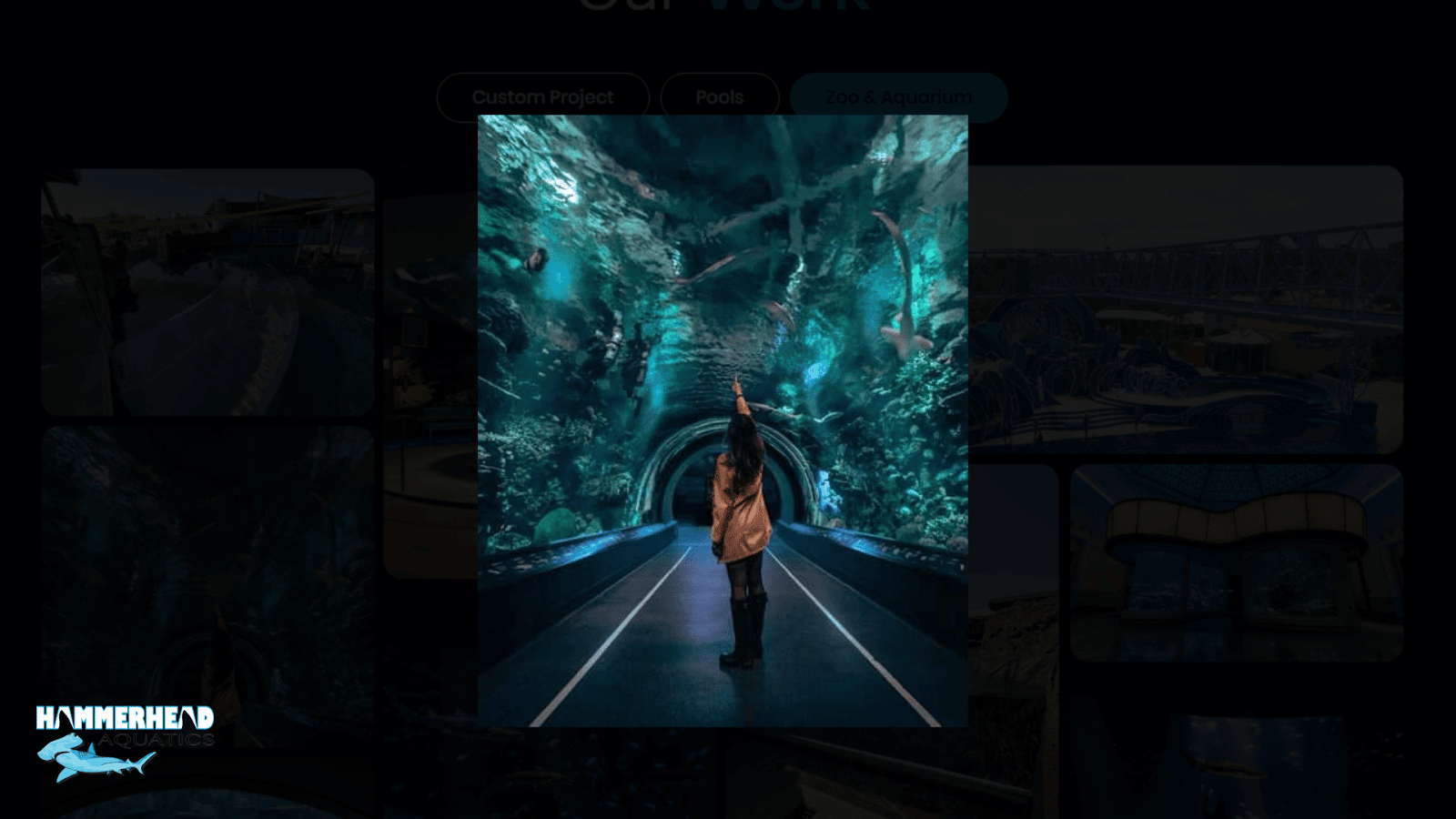
Bullet-resistant or security glazing is essentially multi-layered glass (and plastic interlayers, like polycarbonate sheets) engineered to withstand ballistic or forced-impact attacks. In aquarium terms, you might see this in high-risk public showcases (e.g. zoo exhibits, underwater tunnels facing access areas, or secure installations in politically or socially unstable zones).
Advantages Of Using Bullet-Resistant Glass For Aquariums
- Highest protection: built to resist high-impact, shattering, forced entry.
- Even with multiple projectile hits, panels may maintain integrity.
- Peace-of-mind in extreme security installations.
Disadvantages Of Bullet-Resistant Glass
- Extremely high cost (orders of magnitude above standard aquarium panels).
- Very thick and heavy; installation is complex and expensive.
- Optical challenges: multiple layers, interfaces, reflections, and optical distortion.
- Most overkill for ordinary aquarium use.
When To Use Bullet-Resistant Glass
- Exhibits in high-security zones (e.g. border exhibits, high-profile public aquariums).
- Tanks adjacent to walkways or public areas with risk of vandalism.
- When building underwater tunnels or walls facing public access.
Cost Considerations
Expect cost multipliers of 5× to 20× over conventional glass. A 1 m × 1 m, 50–60 mm multi-layer security panel typically starts around $1,500 USD and can exceed $2,000 USD, depending on rating and optical clarity.
Final Thoughts
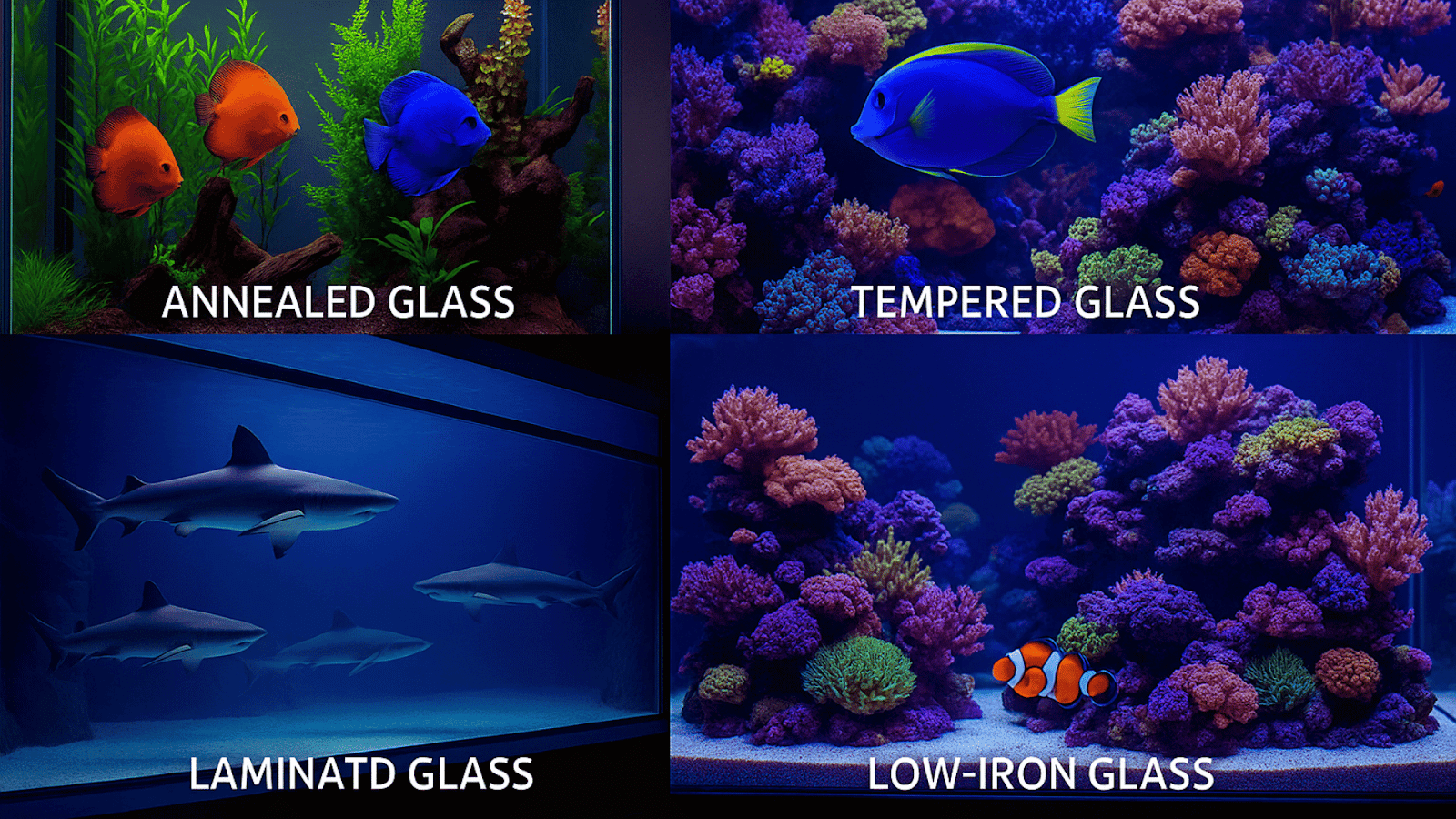
Choosing the right glass for aquariums is not a matter of picking what’s cheapest or easiest to order. It’s an exercise in engineering, materials science, optics, and risk management. Over my 20+ years in aquarium window building and pool-glass work, I’ve seen:
- Tanks built with “safe” margins still fail because the installer ignored edge quality or silicone bonding.
- Ultra-clear panels whose aesthetics degrade from micro-scratches because the owner didn’t understand handling or cleaning.
- Public exhibits blown up (literally) by underestimating impact forces or neglecting laminated safety solutions.
As an aquarium glass pro, here’s my verdict for 2025:
- Use annealed glass for lower-stakes tanks where modifiability is crucial.
- Use tempered for high-stress panels when clarity is acceptable and you don’t need drilling.
- Use laminated glass for safety-critical applications or large displays.
- Combine low-iron (OptiClear / Starphire) with whichever structural glass you choose if optical performance matters.
- Reserve heat-strengthened, wired, patterned, or security glass for niche use cases only after thorough engineering review.
Expert Aquarium Window Installation
As someone who has built dozens of aquarium windows and pool-viewing walls, I know that the final success comes down to:
- Correct glass selection (type, thickness, finish)
- Precision fabrication (edges, flatness, tolerance)
- Expert installation (support, silicone anchoring, bracing)
- Long-term maintenance and protection against scratches, UV, and shock loads
If you're planning a new aquarium, retrofit, or large viewing wall, you may reach my team, Hammerhead Pools, for a free quote based on your requirements.
If you have any questions about what I explained in the article, leave a comment. I will answer from my experience.
Cheers!
FAQs
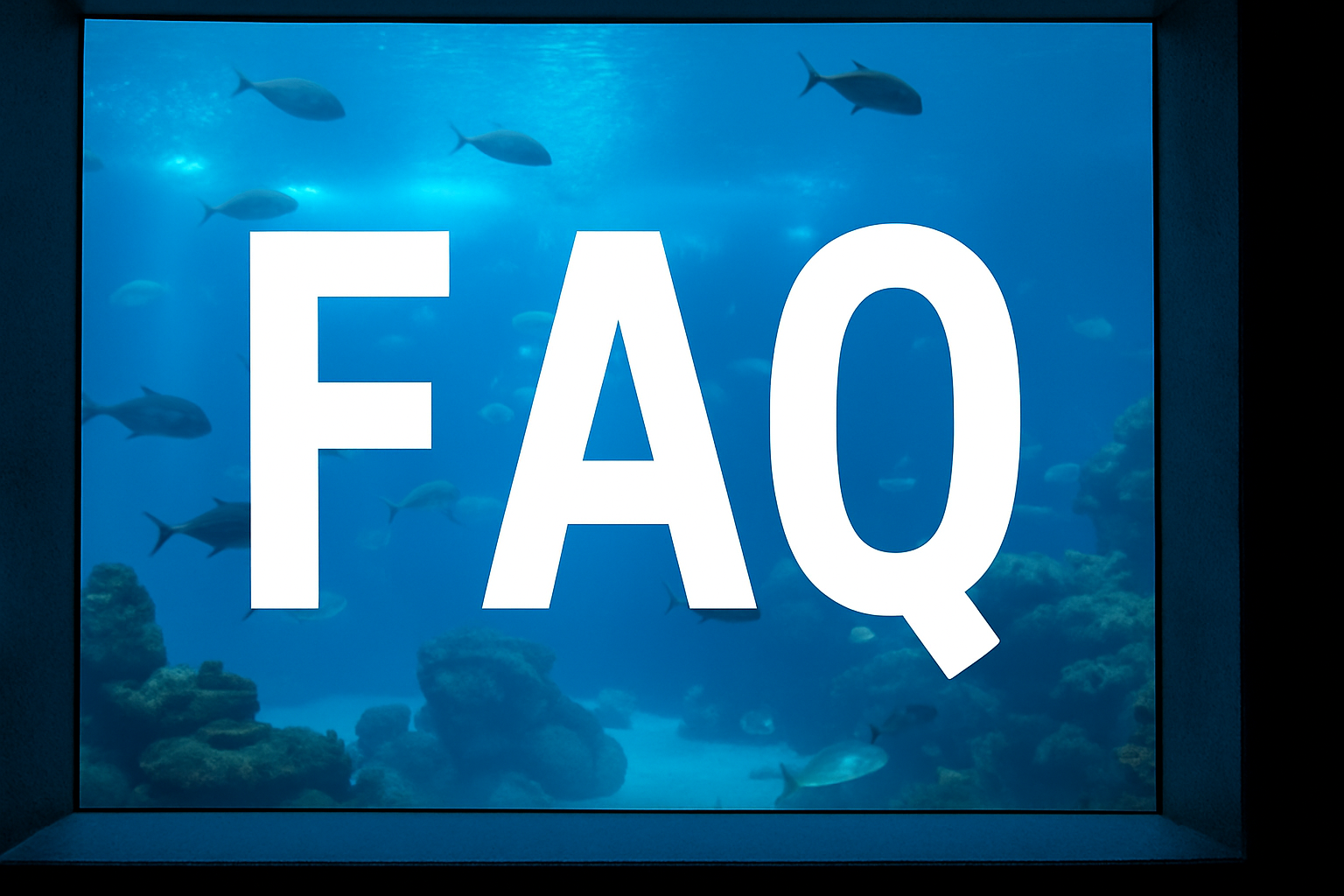
1. What is the best glass type for a large reef tank?
For a large reef tank where clarity and structural safety both matter, many professionals choose a combination: low-iron tempered or laminated front panels, standard tempered sides, and annealed or tempered bottom, with safety margins of 2.5× to 3.5×. Laminated safety or double-laminated low-iron is chosen for viewing windows in public or luxury builds.
2. Can you drill holes in tempered aquarium glass?
No. Once a glass pane is tempered, it cannot be drilled, cut, or modified. Doing so will cause it to crack or shatter immediately. All bulkheads, ports, or plumbing features must be designed before tempering.
3. Is low-iron glass weaker than regular glass?
In many real-world scenarios, no. Low-iron glass is manufactured to comparable structural specifications to regular float glass. However, some aquarists report that ultra-clear glass can be marginally more susceptible to micro-scratches or defects if handled improperly. In most cases, the optical benefit overshadows any slight structural tradeoff.
4. When is laminated glass overkill?
If your tank is small (< ~200 L) or has heavy bracing and modest spans, laminated glass may be overkill due to cost and complexity. In those cases, a well-chosen tempered or thick annealed panel will suffice. Laminated should be reserved for when safety, redundancy, or impact resistance is critically valued.
5. How do you prevent bowing in large glass panels?
You have three main strategies:
- Use thicker glass or stronger glass types (tempered, laminated)
- Add structural bracing (top rails, center braces)
- Use shorter spans or reduce unsupported span length
Also, ensure the glass sits on perfectly flat, rigid supports (no point loading) and that the silicone bonding is uniform.
6. How much thicker should glass be for rimless vs braced tanks?
Rimless tanks require significantly thicker glass because they lack the lateral support that bracing provides. As a rough rule of thumb, rimless may require 25–50 % more thickness (or stronger glass) to maintain the same safety margin. I’ve seen rimless panels built at 20 mm or more just to manage optical deflection, where a braced tank might only need 12–15 mm.
Whether building a new aquarium or upgrading an existing setup, selecting the right glass for aquariums is a decision best made with professional help. Consider not just the upfront cost but long-term durability, safety, and clarity for tank inhabitants and viewers. For high-stress installations, favor tempered or laminated glass; for show tanks and color-focused displays, choose low-iron or specialty aquarium glass. Consult with proven specialists like Hammerhead Pools for expert glass selection, precise installation, and secure, lasting performance. A well-chosen glass type will keep your aquarium thriving and visually stunning for years.











